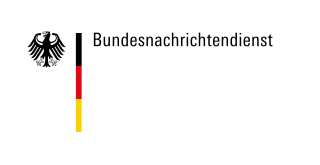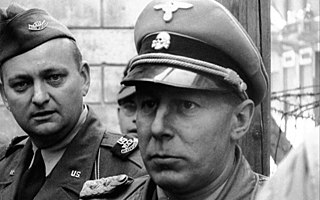Tscherim Soobzokov was a Circassian spy, soldier, and an anti-Soviet pro-independence activist who allegedly collaborated with Nazi Germany during the invasion of the Soviet Union's North Caucasus and served as a Waffen-SS officer before coming to the United States. He rose to prominence in the New Jersey Democratic Party and the Circassian community in Paterson, New Jersey. Soobzokov later denied these allegations and sued CBS and The New York Times. During the Cold War, Soobzokov served the CIA as an anti-Soviet operative. His past was concealed by the CIA when he entered the United States. Soobzokov was murdered by a pipe bomb at his house, allegedly by the Jewish Defense League. He was publicly supported by Pat Buchanan and Congressman Robert Roe.

The Federal Intelligence Service is the foreign intelligence agency of Germany, directly subordinate to the Chancellor's Office. The BND headquarters is located in central Berlin and is the world's largest intelligence headquarters. The BND has 300 locations in Germany and foreign countries. In 2016, it employed around 6,500 people; 10% of them are military personnel who are formally employed by the Office for Military Sciences. The BND is the largest agency of the German Intelligence Community.

The National Security Archive is a 501(c)(3) non-governmental, non-profit research and archival institution located on the campus of the George Washington University in Washington, D.C. Founded in 1985 to check rising government secrecy, the National Security Archive is an investigative journalism center, open government advocate, international affairs research institute, and the largest repository of declassified U.S. documents outside the federal government. The National Security Archive has spurred the declassification of more than 10 million pages of government documents by being the leading non-profit user of the U.S. Freedom of Information Act (FOIA), filing a total of more than 50,000 FOIA and declassification requests in its over 30 years of history.

Walter (Walther) Rauff was a mid-ranking SS commander in Nazi Germany. From January 1938, he was an aide of Reinhard Heydrich firstly in the Security Service, later in the Reich Security Main Office. He worked for the Federal Intelligence Service of West Germany (Bundesnachrichtendienst) between 1958 and 1962, and was subsequently employed by the Mossad, the Israeli secret service. His funeral in Santiago, Chile, was attended by a crowd of old Nazis.

Ratlines were a system of escape routes for Nazis and other fascists fleeing Europe in the aftermath of World War II. These escape routes mainly led toward havens in Latin America, particularly Argentina though also in Paraguay, Colombia, Brazil, Uruguay, Mexico, Chile, Peru, Guatemala, Ecuador and Bolivia, as well as the United States, Spain and Switzerland.
The United States government classification system is established under Executive Order 13526, the latest in a long series of executive orders on the topic. Issued by President Barack Obama in 2009, Executive Order 13526 replaced earlier executive orders on the topic and modified the regulations codified to 32 C.F.R. 2001. It lays out the system of classification, declassification, and handling of national security information generated by the U.S. government and its employees and contractors, as well as information received from other governments.

Krunoslav Stjepan Draganović was a Bosnian Croat Roman Catholic priest associated with the ratlines which aided the escape of Ustaše war criminals from Europe after World War II while he was living and working at the College of St. Jerome in Rome. He was an Ustaša and a functionary in the fascist puppet state called the Independent State of Croatia.

Robert Wolfe was a World War II U.S. Army officer, historian, and retired senior archivist of the US National Archives. He was wounded in both the Pacific and European Theaters of Operation. He commanded a recon team and also an anti-landmine platoon. He was a subject-matter expert on captured Nazi war documents. Wolfe worked for 34 years at the Archives, functioning as its senior specialist for captured German and related records.
Investigative Data Warehouse (IDW) is a searchable database operated by the FBI. It was created in 2004. Much of the nature and scope of the database is classified. The database is a centralization of multiple federal and state databases, including criminal records from various law enforcement agencies, the U.S. Department of the Treasury's Financial Crimes Enforcement Network (FinCEN), and public records databases. According to Michael Morehart's testimony before the House Committee on Financial Services in 2006, the "IDW is a centralized, web-enabled, closed system repository for intelligence and investigative data. This system, maintained by the FBI, allows appropriately trained and authorized personnel throughout the country to query for information of relevance to investigative and intelligence matters."
Walter Kopp was a lieutenant colonel in the Wehrmacht in Nazi Germany. After the Nazi defeat in 1945, he became the chief of one stay-behind network in West Germany, code-named KIBITZ-15. The British and US intelligence services had set up clandestine anti-communist organisations supposed to "stay-behind" in case of a Soviet invasion. Walter Kopp was described by his own North-American handlers as an "unreconstructed Nazi," and the KIBITZ-15 network as "a group with Nazi tendencies" in CIA documents released in June 2006.

Mykola Lebed, also known as Maksym Ruban, Marko or Yevhen Skyrba, was a Ukrainian political activist, Ukrainian nationalist, and guerrilla fighter. He was among those tried, convicted, and imprisoned for the murder of Polish Interior Minister Bronislaw Pieracki, in 1934. The court sentenced him to death, but the state commuted the sentence to life imprisonment. He escaped when the Germans invaded Poland in 1939. As leader of OUN-B he is responsible for the genocide of Poles in Volhynia and Eastern Galicia.
While the United States was involved in the prosecution of people involved in the war crimes of World War II, US military and intelligence agencies protected some war criminals in the interest of obtaining technical or intelligence information from them, or to recruit them for intelligence work. The relationships with German war criminals started immediately after the end of the Second World War, but some of the relationships with Japanese war criminals were slower to develop.
The Gehlen Organization or Gehlen Org was an intelligence agency established in June 1946 by U.S. occupation authorities in the United States zone of post-war occupied Germany, and consisted of former members of the 12th Department of the German Army General Staff. It was headed by Reinhard Gehlen who had previously been a Wehrmacht Major General and head of the Nazi German military intelligence in the Eastern Front during World War II.

The Kono Statement refers to a statement released by Chief Cabinet Secretary Yōhei Kōno on August 4, 1993, after the conclusion of the government study that found that the Japanese Imperial Army had forced women, known as comfort women, to work in military-run brothels during World War II. The Japanese government had initially denied that the women had been coerced until this point. In the Kono Statement, the Japanese government acknowledged that:
The Bund Deutscher Jugend was a politically active German association with right-wing, to right-wing extremist and anti-communist leanings founded in 1950. In the beginning of 1953 the BDJ and its paramilitary arm, the Technischer Dienst, were forbidden as extreme right-wing organisations because of the planned murder of rouhly 40 people and the creation of a secret organization.
Richard David Breitman, born in 1947, is an American historian best known for his study of the Holocaust.

Conspiracy theories about Adolf Hitler's death contradict the accepted fact that he committed suicide in the Führerbunker on 30 April 1945. Most of these theories hold that Hitler and his wife, Eva Braun, survived and escaped from Berlin. While these theories have received some exposure in popular culture, these viewpoints are regarded by historians and scientific experts as disproven fringe theories.
Norman J. W. Goda is an American historian specialised in the history of the Nazi Germany and the Holocaust. He is a professor of history at the University of Florida, where he is the Norman and Irma Braman Professor of Holocaust Studies.

Hunting Hitler is a History Channel television series based on the fringe premise that Adolf Hitler escaped from the Führerbunker in Berlin at the end of World War II. The show was conceived following the declassification of FBI documents exploring whether Hitler might have escaped his apparent fate in Berlin, where he is widely believed to have died in 1945. It explores how might he have escaped, where might he have gone, and whether he plotted a Fourth Reich. The series ran for three seasons between 2015 and 2018, followed by a two-hour special in 2020.










